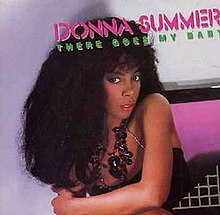There Goes My Baby (The Drifters song)
| "There Goes My Baby" | ||||
|---|---|---|---|---|
 |
||||
| Single by The Drifters | ||||
| B-side | "Oh My Love" | |||
| Released | April 24, 1959 | |||
| Format | 7" single | |||
| Recorded | March 6, 1959 | |||
| Genre | Soul, rhythm and blues, doo-wop | |||
| Length | 2:08 | |||
| Label | Atlantic | |||
| Writer(s) | Benjamin Nelson, Lover Patterson, George Treadwell, Jerry Leiber, Mike Stoller | |||
| Producer(s) | Jerry Leiber and Mike Stoller | |||
| The Drifters singles chronology | ||||
|
||||
| "There Goes My Baby" | ||||
|---|---|---|---|---|
 |
||||
| Single by Donna Summer | ||||
| from the album Cats Without Claws | ||||
| B-side | "Maybe It's Over" | |||
| Released | July 1984 | |||
| Format | 7" single, 12" single | |||
| Genre | Rock,post-disco | |||
| Length | 4:05 | |||
| Label |
Geffen (U.S.) Warner Bros. Records (Europe) |
|||
| Writer(s) | Benjamin Nelson, Lover Patterson, George Treadwell, Jerry Leiber, Mike Stoller | |||
| Producer(s) | Michael Omartian | |||
| Donna Summer singles chronology | ||||
|
||||
"There Goes My Baby" is a song written by Ben E. King (Benjamin Nelson), Lover Patterson, George Treadwell, Jerry Leiber, and Mike Stoller, and produced by Jerry Leiber and Mike Stoller for The Drifters. This was the first single by the second incarnation of the Drifters (previously known as the 5 Crowns), who assumed the group name in 1958 after manager George Treadwell fired the remaining members of the original lineup.
Leiber and Stoller used a radically different approach to production than Ahmet Ertegun and Jerry Wexler had employed with the original Clyde McPhatter-led Drifters. The combination of new style and new group fit, and the song reached number two on the Billboard Hot 100 and number one on the Billboard R&B chart and on the Cash Box sales chart for two weeks, in the summer of 1959. The Atlantic Records release was King's debut recording as lead singer of the group.
The song was included in the musical revue "Smokey Joe's Cafe".
The lyrics are loosely structured, almost free-form at a time when rhyming lines were mandatory. The accompaniment features a violin section playing saxophone-like riffs in rock and roll style. The lead voice is in high gospel-style.
This recording introduced the idea of using strings, a Brazilian baion and elaborate production values on an R&B recording to enhance the emotional power of black music. This pointed the way to the coming era of soul music as the popularity of the doo-wop vocal groups peaked and faded. Phil Spector studied this production model under Leiber and Stoller.
...
Wikipedia
